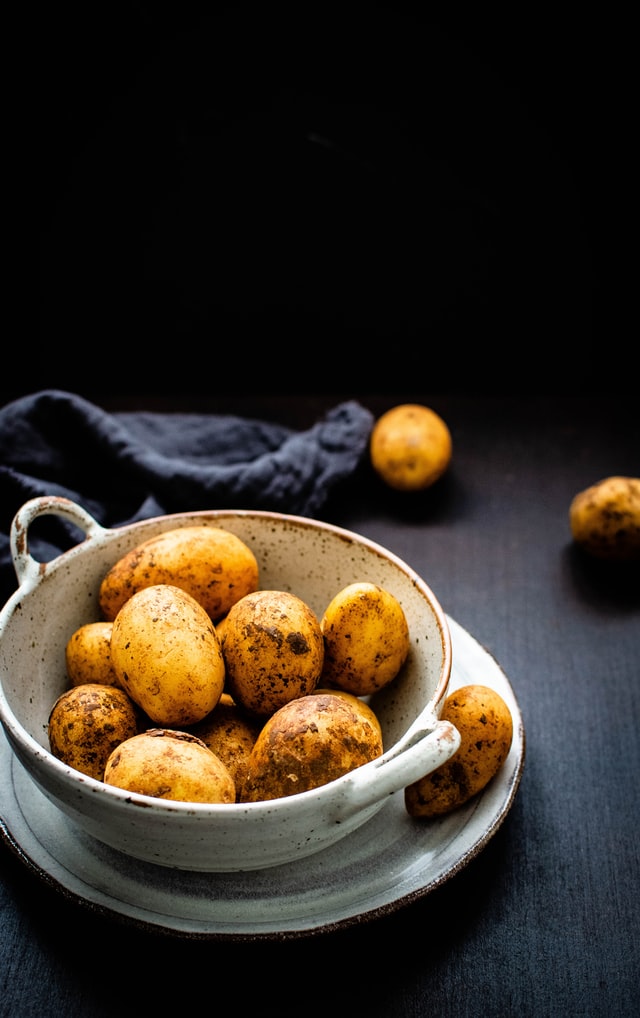
Spudtacular Potato Facts
Let's start with the regular old potato. It's really not all that regular at all...
There are over 4000 varieties of potato in the world today and they are part of the nightshade family . What makes them so special… Are they really that different? Yes!
Potatoes are classified by their starch content and divided into 2 main types: Waxy (or New) and Mealy (or Mature/or Starchy).
Waxy - Waxy potatoes are thin skinned, have a high moisture content, high sugar content, and a low starch content. Most of the varieties of waxy potatoes are small and round though some are long and elongated. The flesh color of waxy potatoes is white, yellow, or blue, and the skin is white, red, yellow, or blue. Waxy potatoes are not optimal for deep fat frying. Great boiled whole and consumed unpeeled. Red potatoes and fingerling potatoes are examples of waxy potatoes.
Pro-Tip when working with Waxy/New Potatoes: As these potatoes have more moisture and less starch, they will absorb less cooking water/mayonnaise/vinaigrette making them more resistant to breaking when tossed in a salad.
Mealy - Mealy Potatoes are thick skinned, have a high starch content, low moisture and a low sugar content. Generally long shaped, they have rougher skin than a waxy potato and is often peeled. As the mealy potato is larger, drier and mealy when cooked, it is great for deep fat frying, baking and mashing. Russets and Idahos are examples of mealy potatoes. Yukon Gold potatoes are mealy potatoes, but due to their thinner golden flesh and golden flesh, make a great all purpose potato that if most often consumed unpeeled.
Pro-Tip when working with Mealy/Mature Potatoes: As these potatoes are drier, starchier, and mealier than waxy potatoes, they become lighter textured when baked. Mealy potatoes are the best for frying because of the low moisture content, they won’t “pop” as much.
Always store potatoes in a dry, dark area when temperatures do not exceed 65-70 degrees. Exposure to light will cause the potato to develop green areas. These areas contain Solanine (a natural deterrent produced when potatoes are uncovered so hungry insects and animals will not eat them) and will be very bitter and are poisonous in large quantities. Any green areas should always be cut off and discarded before cooking. Never refrigerate potatoes as the cool temperature will convert some of the potato starch to sugar making the potato sweet. This process can be reversed if you leave a refrigerated potato at a temperature of 50 degrees for two weeks. Potatoes should have dry, tight skins regardless of if they are mealy or waxy.
And then we get to the important part! Mashed Potatoes - the king of potatoes. Here are some great tips on how to make a perfect mashed potato like a spud muffin. The best, creamiest, purest mashed potatoes. No sour cream, cheese, cream cheese, etc. Just 4 simple ingredients and a whole lotta science.
Mashed Potatoes 101:
· Do you like fluffy or creamy mashed potatoes? Your potato choice matters. Choose russets for fluffy and golds for creamy. Use a combo of both for an amazing creamy and light texture. Save reds and purples for roasting and potato salad.
· Cut your potatoes in larger pieces to boil – smaller pieces take longer, cook unevenly and develop more starch, making pasty potatoes. It's true, I promise!
· Start with cold water and make sure to add salt! This will ensure that your potatoes cook evenly.
· Rinse that starch off the potatoes after boiling. This will help remove some of the starch for a lighter fluffy texture.
· Get rid of as much water as you can. After boiling, drain well. Then place potatoes back into the pan and onto the heat to zap out some of that residual moisture.
· Ditch the mixer. Use a ricer or food mill for perfectly smooth mashed potatoes and a masher for mashed potatoes with a little texture. The motion of the mixer overworks the starches, making that wallpaper paste that we are trying to avoid.
· Warm your ingredients. Don’t ruin all of your hard work by adding cold butter and cream to your mashed potatoes. This is the last step to your perfect mash!
So next time you're thinking about whipping up some potatoes, put a little science behind your recipe!
Here are four of our favorite potato recipes:
